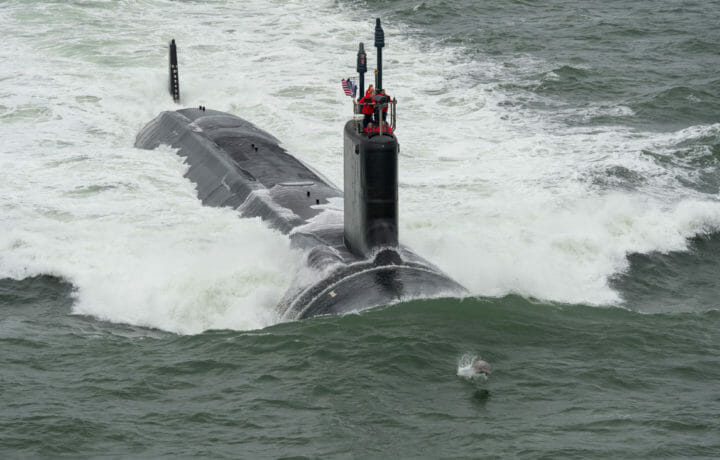The United States Navy has seen numerous delays with its Virginia-class attack submarine program, and it was a year-and-a-half ago the Government Accountability Office (GAO) warned that staffing problems and supply chain issues mean the nuclear-powered boats were running about two years late. Since the release of the watchdog group’s report, the latest submarines are even up to three years behind schedule.
However, the sea service and the submarine industrial base have been working to address the issue, and USNI News reported that shipbuilders General Dynamics Electric Boat and HII’s Newport News – the two firms charged with the manufacture of the submarines – are in the process of finalizing the detail design and construction contracts for the future Block V boats USS Baltimore (SSN-812) and USS Atlanta (SSN-813).
“As part of the Fiscal Year 2024 defense spending bill, Congress appropriated $9.4 billion for the two boats, but were short by almost $2 billion to cover the rising cost of labor and supplies,” USNI News reported.
That approval from lawmakers will “allow the Navy to cover fact-of-life cost increases on the two FY 24 boats and one FY 25 boat. They also provide funds for additional workforce development and allow us to target funding at specific productivity areas that we are working at with our customer,” General Dynamics CEO Phebe Novakovic said in a Jan. 29 earnings call. “We are working with our customer to get this under contract as soon as possible.”
Could SAW Cut It?
Last fall, a bipartisan group of United States Senators – led by Sen. Tim Kaine (D-Va.) – submitted a letter to the United States Navy and White House Office of Management and Budget (OMB), requesting new details on the Navy’s Shipyard Accountability and Workforce Support (SAWS) funding plan.
SAWS had been proposed in September to allow the sea service to take some labor funding that has been approved for the building of future submarines and redirected to address the current worker shortage at America’s shipyards. As USNI News further reported, SAWS could have allowed the shipyards to “create a pool of more than $10 billion to apply more freely to infrastructure and labor costs.”
Even as lawmakers have questioned whether SAWS would be able to cut through the delays, it still has the support of the sub-industrial base.
“Block VI and Columbia Build II, we’re going to have to see the acquisition approach for those boats they developed,” HII CEO Chris Kastner said during a Thursday earnings call. “Anything that brings additional investment into the industrial base that accelerates shipbuilding production is positive, but we’re going to take this one step at a time.”
Some Navy officials have also championed the reallocation of the money.
“I would say that bottom line, regardless of the fiscal strategy that was, some of the functionality that SAWS provided for would help the yard be better at building submarines,” Vice Adm. John Skillman, deputy chief of naval operations for integration of capabilities and resources (N8) while speaking to USNI News at the WEST 2025 conference last month.
All About the Base
Last September, the U.S. Navy announced a partnership with private industry to further grow the submarine industrial base capacity. As part of former Navy Secretary Carlos Del Toro’s Maritime Statecraft initiative, it includes rebuilding the manufacturing base that has shrunk to just one-third of its capacity from only 30 years ago.
The sea service is calling for submarine production to nearly double, requiring an additional 3.5 to 4.5 million submarine module production and outfitting hours annually.
The Block V – Crucial to America’s Defense
A total of 66 fast attack submarines of the Virginia class have been planned, with 24 completed – of which all but one is currently in service – while 10 are under construction and four more on order.
The boats were developed in the 1990s to incorporate the latest in stealth, intelligence gathering, and weapons systems, and to replace the U.S. Navy’s aging older Los Angeles-class submarines. The Virginia class was further designed to conduct a broad spectrum of open-ocean and littoral missions, including anti-submarine warfare (ASW) and intelligence-gathering operations.
The final variant of the new submarines is the Block V, which differs from the preceding Block IV boats by 20%. It is larger than the previous versions with a length increased from 377 feet to 460 feet, and greater displacement from 7,800 tons to 10,200 tons. As a result of these changes, the Block V versions of the Virginia class are the second-largest U.S. Navy submarines produced behind only the Ohio class.
The added 83-foot section was to increase the number of missile launch tubes from twelve to forty, which in essence could triple the capacity of short targets for each boat. This extended mid-body section – the Virginia Payload Module (VPM) – can also be used to store and fire additional Tomahawk cruise missiles and other payloads; including large-diameter unmanned underwater vehicles (UUVs).
Moreover, the VPM provides the already heavily armed Virginia class a massive increase in capabilities, essentially allowing it to take the role of the four Ohio-class ballistic missile submarines (SSBNs) that were converted to cruise missile submarines (SSGNs) in the 1990s. Each VPM has the capacity for 40 cruise missiles, while it also increased the number of torpedo-sized weapons carried by each submarine from about 37 to about 65, an increase of 76%.
Though the boats have increased capabilities, the shipyards will need to increase their efforts to see that these boats are completed on time.




